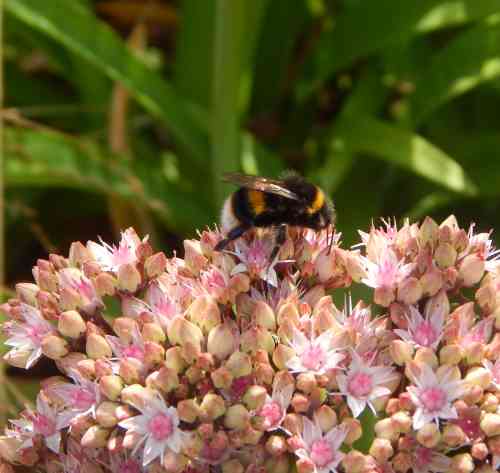Flower Pollination And
Pollination Syndromes
Here, I’m going to discuss flower pollination, and in particular, describe how flowers are adapted to attract their most important partners - that is, how they use pollination syndromes in the pollination process to attract their perfect pollinating insects.
It’s well known that insects have a vested interest in visiting flowers – that is, they’re not merely visiting the flowers with the altruistic intention of performing a passing pollination service. They’re usually gathering nectar and/or pollen. Thus both the plant and insect benefit from their relationship with each other.
How flowers attract bees and other pollinators
Given the huge variety of shapes, sizes, features and characteristics of both insects and flowers, and the amazing interdependence, it's essential in nature to understand that one species cannot always compensate for another. This is why it is so important to protect biodiversity, because all creatures play a role in the great web of life.
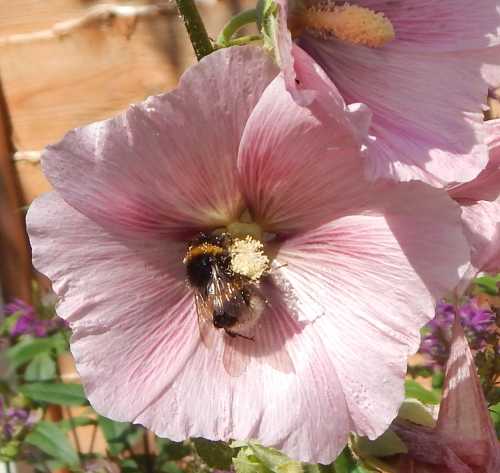 Flowers are adapted to attract their perfect pollinators. Above, this bumble bee with its hairy body, is well suited to pollinating the hollyhock flower.
Flowers are adapted to attract their perfect pollinators. Above, this bumble bee with its hairy body, is well suited to pollinating the hollyhock flower.So,
how do different flowers attract the right insect for the job?
How do flowers vary their features to appeal to their target visitors - i.e. what kinds of ‘pollination syndromes’ have they developed?
Let’s take at look at them here.
1. Scent
How about the stench of rotting flesh as a pollination syndrome?
Humans love fragrance, and so do insects........But
different insects like different fragrances! On the one hand, sweet
peas have a scent that can charm the bees. Butterflies also like fresh,
but very delicate scents.
However, this is not the kind of fragrance that appeals to all pollinators.
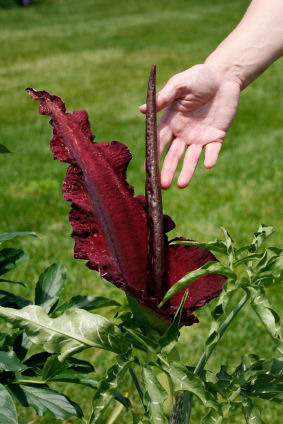 Some plants like the Voodoo Lily - Sauromatum guttatum give off what humans would consider a 'foul stench', but that is attractive to certain flies and beetles.
Some plants like the Voodoo Lily - Sauromatum guttatum give off what humans would consider a 'foul stench', but that is attractive to certain flies and beetles.A number of flowers produce what humans would consider to be a foul stench. For example, the Voodoo Lily - Sauromatum guttatum
(pictured right), from the ‘Aroideae’ plant family, emits an odour that is
likened to rotting flesh. Other similar ‘Aroideae’ plants include:
- the Titan arum (Amorphophallus titanum),
- the Dead horse arum lily (Helicodiceros muscivorus)
– so called because it produces a scent that mimics a dead animal's
(horse’s?) hind quarters, even to the point of converting part of the
spathe (the tall spike from the centre) into a hairy tail!
- the Dragon lily (Dracunculus vulgaris),
- and Wild arum (Arum maculatus).
From a different plant family, the Orontiods, the Eastern Skunk Cabbage (Symplocarpus foetidus) and Western Skunk Cabbage (Lysichiton americanus), are also said to give off the horrible odour of decaying flesh.
So
who or what is attracted to these plants?
Primarily carrion flies and beetles (i.e. flies and beetles that are attracted to dead and rotting bodies of animals etc).
2. Scent And The Time Of Day
The time of day also plays a role in attracting pollinators. In some cases, flower pollination actually takes place in the evening, and therefore, scent as a pollination syndrome, has to be stronger in evenings.
Flowers pollinated by bats and moths, for example, are strongly scented at night, such as night-scented Stocks, Eryngium giganteum, Evening primrose, Globe Artichoke, Honeysuckle (eg Lonicera ‘Graham Thomas'), Jasmine (Jasminum officinale), Tobacco plant (Nicotiana sylvestris) and Verbena bonariensis. Interestingly in some tropical regions, a number of bees fly out to forage at night.
3. Colours And Patterns
I am often asked during my talks
about bees, whether bees prefer particular colours. Like humans, bees
are trichcromatic.
This means their eyes (like ours) have 3 colour receptors. However, whereas humans base their colour vision on the colour receptors red, green and blue, bees base their colour vision on Ultra Violet, blue and green, and officially, bees cannot see the colour red.
However, although bees cannot see red, they do visit red flowers because flower petals have Ultra Violet patterns on them, not visible to humans in normal light, but visible to bees.
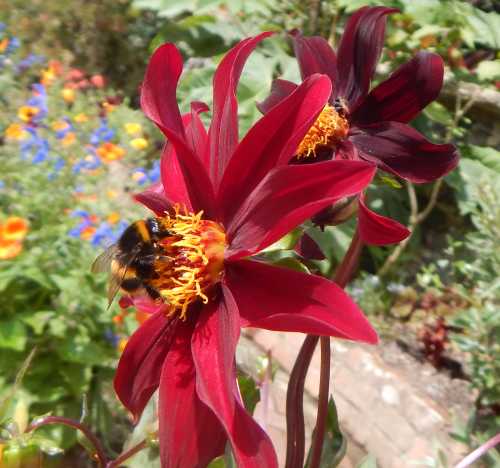 Bumble bee on red dahlia flower.
Bumble bee on red dahlia flower.The patterns are believed to guide the bees onto the flower ‘landing platform’, and then into the flower.
However, all in
all, it is also thought that bees prefer different shades of blues,
whites, and purple flowers.
In general, it’s believed that
swathes of colour are also more helpful to foraging bees and
butterflies, providing a stronger visual signal that suggests ‘plenty of
food here’ , and of course, it is more energy efficient for bees and
other pollinators to find areas of denser food provision.
4. Flower Shape And Nectar Provision
Flower pollination is
also aided by the very shape of the flower, and the way in which insects
come into contact with its sexual parts (the carpels and stamen). For
example, even within the bee familes, the shapes, sizes and weights of
the bees vary, as do the tongue lengths.
Whilst honey bees
have quite short tongues for sucking up nectar, some of the bumble bees
have long tongues, meaning they may target deep, tubular shaped flowers.
For example, with their furry, roundish bodies, they are ideal
pollinators for foxgloves, their coats being efficient catchers of
pollen as they make their way up inside the flowers.
Flowers
have different nectar re-fill rates - yes, once the nectar is taken by
one insect, the flower may replenish the nectar ready for the next
passing insect. This helps to ensure that a plant can be visited more
than once, increasing its chances of pollination.
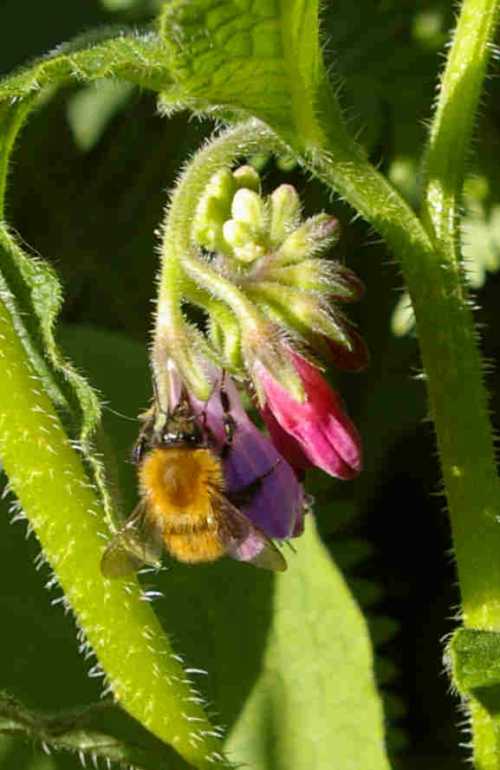 Above: bumble bee nectar robbing comfrey
Above: bumble bee nectar robbing comfreyHowever, insects may cheat the plant!
In cases where short
tongued bumble bees cannot get at nectar stores in the base of flowers,
they may bite a hole, and access the nectar in that way. This is called
‘nectar robbing’. The hole may then be visited by other insects also
keen to take the nectar, as the nectar supply is replenished. This is
called ‘secondary robbing’.
Opinions vary, but some state that
flower pollination is not necessarily hindered, because the flower may
still be targeted by other bees that are engaged in gathering pollen,
rather than nectar.
On the other hand, flowers may cheat insects too!
The Bee Orchid (Ophyrys apifera)
is believed to have evolved to emulate the appearance of the female
bee of the species required to pollinate it. The male bee lands on the
female with the intention to mate. In his attempt, the orchid is
pollinated. The bee, however, is disappointed!
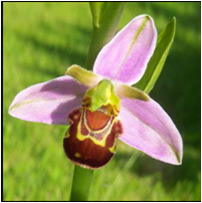 The Bee Orchid (Ophyrys apifera).
The Bee Orchid (Ophyrys apifera).Orchid pollination is not only carried out by bees. Certain beetles such as the beetle Strangalia maculata , are also able to assist in orchid pollination, as they can efficiently access the complex flower structures of some wild orchids.
In contrast to flower pollination, which requires the aid of insects,
birds or bats, flowers that are wind pollinated (requiring no
intervention from other moving creatures), do not have the visual or
fragrance cues of other plants. They are generally dull in colour, with
no fragrance or nectar to entice an insect.
Below are a number of books about bees and pollination for further information:
Find out more about flower pollination and related subjects by clicking one of these links:
